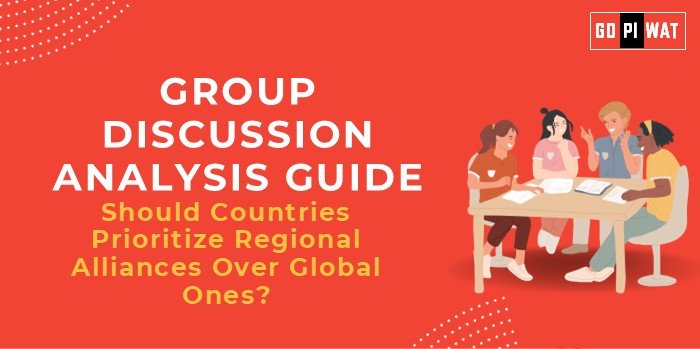📋 Group Discussion (GD) Analysis Guide
🌟 Should Countries Prioritize Regional Alliances Over Global Ones?
🌐 Introduction to the Topic
Opening Context: “In a world where global interdependence and regional dynamics often intersect, the debate over prioritizing regional alliances versus global ones is pivotal. It reflects strategic, economic, and cultural considerations crucial for national security and development.”
Background: The concept of alliances is rooted in history, from NATO to ASEAN. Recently, the rise of regional groupings like the African Continental Free Trade Area (AfCFTA) and the European Union showcases the increasing influence of localized cooperation. However, global alliances, such as the United Nations and G20, continue to shape worldwide governance.
📊 Quick Facts and Key Statistics
- 🌍 Global Trade through Regional Agreements: Over 50% of global trade occurs under regional agreements (WTO, 2023).
- 🌎 NATO Membership: Includes 31 countries with a collective GDP of $46 trillion (2024).
- 💰 China’s Regional Partnerships: Drives $1 trillion in Belt and Road projects with regional allies (World Bank, 2023).
- 📈 EU Trade Volume: $6.5 trillion intra-regional trade in 2023 (Eurostat).
👥 Stakeholders and Their Roles
- 🏛️ Governments: Shape foreign policy based on security, trade, and cultural affinity.
- 🌐 Regional Organizations: Facilitate cooperation within specific geographies (e.g., ASEAN, SAARC).
- 🏢 Global Institutions: Address transnational challenges like climate change (UN, WHO).
- 💼 Private Sector: Leverages regional agreements for trade while relying on global standards for innovation and expansion.
🏆 Achievements and Challenges
- 🎯 Achievements:
- Regional Alliances: ASEAN’s successful economic integration boosted member GDPs by 6% annually since 2010.
- Global Alliances: Paris Agreement (2015) united over 190 nations in combating climate change.
- ⚠️ Challenges:
- Regional Limitations: SAARC’s lack of cohesion weakens its potential.
- Global Challenges: Consensus-building in global alliances like the WTO is slow due to divergent interests.
🌍 Global Comparisons
- 🌟 Regional Success: EU vs. ASEAN (EU’s greater economic and political integration).
- 🌍 Global Impact: The G20 effectively addressed post-2008 financial crises but struggles with climate commitments.
Case Studies:
- 📈 RCEP’s Trade Growth: Strengthened Asia-Pacific trade connectivity.
- 🛡️ NATO’s Ukraine Response: Highlights strategic regional defense over global unanimity.
📋 Structured Arguments for Discussion
- ✔️ Supporting Stance: “Regional alliances like ASEAN have demonstrated effective economic cooperation, allowing members to tailor policies to shared interests and geography.”
- ❌ Opposing Stance: “Global alliances remain indispensable for addressing transnational issues like pandemics and climate change, which regional efforts alone cannot tackle.”
- ⚖️ Balanced Perspective: “While regional alliances offer tailored benefits, global alliances are critical for universal challenges, suggesting a complementary approach.”
🛠️ Effective Discussion Approaches
- 🔍 Opening Approaches:
- Statistical: “Over 50% of trade today is facilitated through regional agreements, showcasing their growing relevance.”
- Comparative: “Regional versus global alliances can be seen as the grassroots and treetops of diplomacy, both essential yet distinct.”
- 💬 Counter-Argument Handling:
- Acknowledge the merits of global efforts (e.g., climate change).
- Emphasize regional adaptability (e.g., tailored trade policies).
📈 Strategic Analysis of Strengths and Weaknesses
- 🟢 Strengths:
- Regional: Quick decision-making, shared cultural/economic goals.
- Global: Scale of impact, diverse perspectives.
- 🟡 Weaknesses:
- Regional: Risk of isolationism.
- Global: Bureaucratic delays.
- 🔵 Opportunities:
- Regional: Strengthen local markets.
- Global: Address cross-border issues collaboratively.
- 🔴 Threats:
- Regional: Over-reliance on neighbors.
- Global: Erosion of sovereignty.
📚 Connecting with B-School Applications
- 🌏 Real-World Applications: Research in global supply chains or regional trade dependencies for consulting/operations projects.
- 🤔 Sample Interview Questions:
- “How can countries balance regional priorities with global responsibilities?”
- “What lessons can the EU provide to regional alliances like SAARC?”
- 💡 Insights for Students:
- Explore case studies on alliances for project insights.
- Analyze implications on global markets and policy-making.


